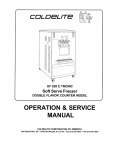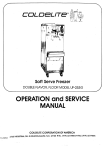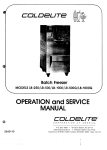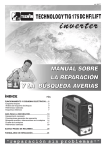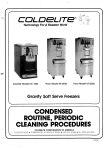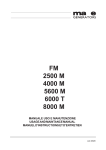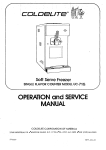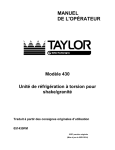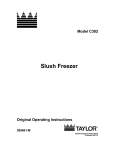Download Coldelite UC 511 G Service manual
Transcript
UC 511 G Soft Serve Freezer SINGLE FLAVOR COUNTER MODEL OPERATION & SERVICE MANUAL COLDELITE CORPORATION OF AMERICA 3760 INDUSTRIAL DR. * WINSTON-SALEM, N.C.27105 * TEL.(910) 661-9893 * FAX (910) 661-9895 39 FOREWORD Thank you for selecting COLDELITE to meet today’s fast growing demands. Your COLDELITE freezer has been manufactured at one of the most modern manufacturing plants, utilizing the most advanced equipment and technology available in the industry. We at COLDELITE, take great pride and care in the manufacture of each and every freezer, using only the finest components available, to provide you with years of trouble-free operation. Over thirty years of experience in the manufacturing of dispensing equipment have guided us in the preparation of this Operation and Service Manual. PLEASE READ IT CAREFULLY. Keep it for future reference and most of all, follow the instructions from the very time your machine is put into service. On the following pages, you will find important information and procedures which describe the proper installation, sanitizing, operation, and maintenance of your COLDELITE machine. We feel certain that your full compliance with these instructions will assure you of excellent performance, trouble-free operation and profitable business for years to come. All technical data, pictures and drawings contained in this manual are not binding on the manufacturer, nor can the manufacturer be held liable for any modification of the machine in part or completely. CODE: 5543360/5 1 2 INDEX Page FOREWORD PART I 1 INSTALLATION A) Uncrating B) Positioning the Machine C) Electrical Requirements D) Completing the installation 5 5 5 6 6 EXPLANATION OF CONTROLS 7 A) Electronic Control Panel B) The Dispense Handle C) Proximity Switch D) Safety Switch E) Electric Control Panel F) Other Controls 7 8 8 8 8 9 PART III INITIAL CLEANING PROCEDURE 10 PART IV ASSEMBLING THE FREEZER PART II 14 A) Assembling the Beater/Augers B) Assembling the Dispensing Head C) Assembling the Gravity Feed Tubes 14 15 17 PART V SANITIZING THE FREEZER 18 PART VI STARTING THE FREEZER 21 PART VII OPERATING THE FREEZER 23 PART VIII ROUTINE, PERIODIC CLEANING PROCEDURES 25 PART IX TECHNICAL INFORMATION A) Refrigeration B) Beater Motor C) Overload D) Proximity Switch 26 26 26 26 27 MAINTENANCE 27 A) Trouble Shooting Guide B) Parts Identification C) Wiring Guide D) Spare Parts List 28 29 35 37 PART X 3 4 Important Failure to closely follow operational and maintenance procedures may result in damage to the unit and/or void your warranty. Coldelite Corporation will not be responsible for any machine not properly maintained. In the event this unit should malfunction, please contact your Coldelite Distributor or an authorized service agency. PART I INSTALLATION Before starting this procedure, make sure the shipping case does not show any evidence of having been dropped, tampered with or abused in such a way as to indicate that its contents may have been damaged in transit. 8" IMPORTANT: Should the outside of the shipping case give any indication of possible hidden damage, state this on the bill of lading before signing. Contact the carrier immediately and request an inspection of damage. If this procedure is not adhere to, you will forfeit your right to file damage claim and be responsible for subsequent repair costs. 6" Air Flow A)Uncrating Proceed, as follows: Rear View 1) The case is secured to the skid with plastic strapping. When you cut this strapping, do it with caution, as it may spring out. Remove case by lifting it straight up and away from the machine. Figure 1 Clearances Required for Air Cooled Models 2) The freezer is also secured to the skid with plastic strapping. Exercise caution and cut this strapping to free the machine from the skid. 2) The freezer is now ready to be positioned onto your counter. The counter must be capable of supporting 180 lbs. and should be vibration free. Reinforce it, if necessary. Remember when choosing a location, if your unit is air cooled, proper air flow will need to be maintained. Allow at least 8 inches on left side and a minimum of 6 inches between the right side of the machine and any obstruction. (Ref. Fig. 1). 3) Remove the single screw at the bottom of each side panel. Remove the panels by sliding upward slightly, then pull outward at the bottom and allow the panel to slide down. The protective plastic coating which i s laminated to the panels can now be removed by simply peeling off. Note: If these clearances are not maintained, the production capacity will be reduced, cycling will increase and the potential will exist that the machine will stop completely. B)Positioning the Machine 1) The freezer is shipped without legs installed. To install the legs, lift the freezer and screw the four legs into the bottom of the frame at each corner. When the freezer is placed in the desired location, it must stand level. Level the freezer by turning the bottom part of each leg in or out. Check for level condition by placing level on the top of the freezer at each corner. 3) It is necessary to clean the condenser each month to eliminate dust, paper, etc. which may obstruct it, damaging the proper functioning of the machine. 4) The machine should also be within six feet of the power supply (a plug and receptacle or unfused disconnected). NOTE: Accurate leveling is necessary for correct drainage of freezer barrel and to insure correct over-run. 5) Position the machine for easy accessibility for cleaning, servicing and maintenance. 6) Position the machine away from direct sunlight. For every 2°F over 68°F, the machine’s performance will decrease by approximately 1%. 7) Once the machine is set in position, it should be leveled as accurately as possible. 5 The compressor is also internally protected. If the Klixon protector trips due to an overload, again the protector must first cool down for several minutes before the compressor can be restarted. C) Electrical Requirements All wiring installed to operate this freezer must be in accordance with the National Electrical Code and/or local electrical codes, rules and regulations. The machine must be properly grounded. It is recommended the power supply be installed by a licensed electrician. Electrical Connections (Ref. Fig. 5) Having removed the right side panel, the machine’s wiring connection box can be found on the bottom of the frame and is labelled “Connect Power Line Here”. Voltage UC 511: 115 Volts Total Running Amperage FLA: 18 Amps. Fuse Size: 20 Amp. Max. Wire Size (50 Ft. Max.): # 10 The power line is first passed through the access hole located at the bottom deck directly below the wiring connection box. The power line may then be connected to the machine’s power lines and wiring connection box. Upon completion, the power line should be fastened to the wiring connection box with appropriate electrical hardware. Power Supply must be adequate to meet requirements at all times. Voltage fluctuations, with the machine in operation, should not exceed ± 5% of the normal or rated voltage. Adequate Wiring must be provided with respect to wire size or gauge. Unless otherwise required by the local Electrical Code, the same size wire gauge at the machine junction box should be used for direct power line. A separate circuit breaker with adequate fuse protection should be employed. An unfused disconnected switch or a properly sized plug and receptacle within 6 feet of the freezer, is recommended. Figure 5 Coldelite freezers are equipped with protection for the beater motor. Should the line voltage drop, or in the unlikely event a short circuit occurs, the overload protector will automatically disconnect the starter and the machine will stop immediately so that no permanent damage can be caused to the motor. In all installations, the machine must be properly grounded. Since all high voltage components (controls are 24 volts) are connected by means of flexible conduit, or cord, adequate ground continuity is assured by running and fastening a ground line to the machine junction box ground lug. (Ref. Fig. 5). To restart the freezer, depress the STOP/RESET button located on the front switch pad. The heater protection must cool down for several minutes before the RESET will operate. See Fig. 4. Beater Rotation After electrical connections are completed, check the rotation of the beater. It should be counter clockwise when facing the front of the machine. D) Completing the Installation On the following pages, you will find important information and procedures which describe the proper installation, sanitizing, operation and maintenance of your COLDELITE machine. We feel certain that your full compliance with these instructions will assure you of excellent performance, trouble-free operation and a profitable business for years to come. NOTICE: Failure to closely follow set-up and maintenance procedures can void your warranty. Coldelite Corporation will not be responsible for any machine not properly maintained. In the event this unit should malfunction, please contact your Coldelite Distributor or an authorized service agency. WARNING:EXTREME CARE MUST BE TAKEN WHEN REMOVING SIDE, REAR OR CONTROL BOX PANELS. ALWAYS TURN THE MACHINE TO THE OFF POSITION. ALSO TURN OFF THE DISCONNECT SWITCH ON ELECTRICAL SUPPLY LINE BEFORE EXPOSING ANY ELECTRICAL CONNECTIONS AND/OR MOVING PARTS, SUCH AS BELTS, PULLEYS, FAN BLADES AND BEATER. Figure 4 6 Stand-by function This position is used during prolonged idle periods. The temperature of the product in both the mix tank(s) and freezer cylinder (s) is held at a safe temperature and controlled automatically by the thermostats. Product should never be served when in this position as the “storage” temperature is higher than normal serving temperatures. PART II EXPLANATION OF CONTROLS A) Electronic Control Panel In this position the beater motor is ON when the system is cooling the cylinder, beater motor is OFF when the system is cooling the hopper which will allow significant ENERGY CONSERVATION. 570 Beater function With this function on, pilot light pos. L4 on, only the beater turns while the refrigeration system is cut out. This function is timed and ends automatically when the set time is over. About 15 minutes. L1 571.1 571.2 Hopper Mix level indicator This pilot light pos. L5 indicates that the level of the mix in the hopper has reached the minimum allowed, and that more mix must be added. L2 When illuminated, dispensing of product should be stopped and the tank refilled with mix. Each tank has a total capacity of 6 qts each when full. L3 L4 The MIX LEVEL SWITCH is located within the stainless steel/ plastic rod attached to the bottom of each mix tank. L5 Positions L1/L5 Lighted function indicators These indicators illuminate to show that the function corresponding to the signal next to the indicator itself is on. Monitor pos. 570 This numerical monitor displays the consistency of the product when the machine is turned on and while it is operating in AUTOMATIC. Stop/Reset button pos. 571.1 With the Stop/Reset function on, pilot light pos. L1 lit, the machine is ready to receive the command for any of the main functions. Select button pos. 571.2 By pushing this button you can select the functions: -Automatic -Stand-by -Beater Indicators illuminate to shown that the function corresponding to the signal next to the indicator itself is on. Automatic function When this function is on, pilot light pos. L2 lit, the product is processed until it reaches the proper consistency (preset HOT setting). During this function, The Monitor displays a number indicating the consistency of the product in the cylinder until it reaches the set value, then it indicates the temperature of the mix in the hopper tank. 7 B) THE DISPENSE HANDLE D) SAFETY SWITCH The Dispense Handle controls the flow, or extraction rate of finished, soft serve product. Machine is equipped with a magnet molded into the spigot head. If the spigot head is removed the magnet deactivates a safety switch behind the front panel. The machine will not operate with the spigot head removed. A message "MIP" will appear on the display. Pulling the handle in a downward direction will open the dispense orifice. When the unit is in the “AUTOMATIC” mode, this will allow finished product to be extracted and served. E) ELECTRIC CONTROL PANEL The Electric Control Panel located behind the upper rear panel of the unit, contains the controlling circuit to the components of the machine. This panel is to be accessed only by trained, experienced technicians. Warning Disconnect freezer from the source of electrical supply before attempting to service. 1 2 3 4 5 C) PROXIMITY SWITCH In AUTOMATIC function the proximity switch pos. 152 starts the motor when the hand, handling cup or cone, is in the range of the sensitivity preset by Coldelite. Note: Keep the sensor always clear and clean. Adjusting Proximity Switch The proximity switch pos. 152 has been preset at the factory and its range is approximately 9 inches. If modification is required, contact authorized service agency as this operation must be carried out by specialized technicians. 6 152 8 7 8 9 The following is an explanation of the control panel controls: F) OTHER CONTROLS 1) BEATER MOTOR STARTER - activates the beater/auger drive motor. In the "BEATER" mode, the starter is energized by the front switch pad. In the "AUTO" mode, the starter is activated by either the proximity switch or timer. 1) Refrigeration SOLENOID VALVES are located behind the left side panel. These valves are normally closed and when energized by the electronic board, direct refrigerant flow to either the freezing cylinder or mix tank. The mix tank solenoid is identified as "EVV" and the cylinder solenoid as "EVC". 2) COMPRESSOR CONTACTOR - activates the refrigeration compressor. When the unit is in the "AUTO" mode, the compressor contactor can be energized by the electronic H.O.M., timer, or "TEV" thermostat. In the "ENERGY CONS." mode, the contactor will be energized by the electronic board. 3) The OVERLOAD PROTECTOR senses the current supplied to the beater motor and will stop the entire machine in the event of an overload. This device also houses the overload reset mechanism. 4) The main TRANSFORMER steps down the line voltage (115 Volts) to 24 Volts for the control circuit. 2) The HIGH PRESSURE CUT-OUT is located on the right side of the freezer and is tied into discharge or high side line near the compressor. In the event of high pressure situation, it will shut down the compressor. Reset is automatic when the high pressure subsides. Common causes for cut-out or shut down arerestricted air flow on air cooled models, unusually high ambient (room) temperatures, and restricted or excessively hot water flow on water cooled models. 5) ELECTRONIC BOARD - controls all the functions of the machine. - Temperature of the product in hopper. - Consistency of the product. - Timer. - In stand-by controls temperature of the product in hopper and cylinder. - Controls and or energizes all the information or messages displayed on the monitor. 6) FUSE - protects 115 voltage line. 7) The CURRENT TRANSFORMER monitors beater motor current for the electronic H.O.M. 8) TRANSFORMER - Steps down the 24 volt line to 11 volts for the electronic board. 9) The 24 volt TERMINAL BLOCK serves as the inter-connection point for all 24 volt controlling circuit components. 9 Once removed, the tube must be disassembled. To disassemble, first remove the “SPLASH GUARD” by pulling it out of the tube. PART III INITIAL CLEANING PROCEDURE This is a new machine and it must be completely disassembled, washed, and sanitized before starting. Proceed, as follows: 1) Remove the mix tank cover and items packed in the tank (spare parts, sanitizer, lubricant). The spare parts or start-up kit will include: 1) a spatula, 2) spare o-rings and rubber seals, 3) an o-ring extractor, 4) a tube of sanitary lubricant, 5) three various sized cleaning brushes, 6) several packets of sanitizer and the OPERATIONAL MANUAL. HELPFUL SUGGESTION: Before proceeding with the disassembly of the freezer, we recommend a plastic dish pan be used in which to place the parts. This will minimize the possibility of misplacing or damaging the various component parts. Next, remove the gravity tube “SLEEVE” by pulling it straight off the tube. 2) Proceed with the disassembly process by removing the gravity feed tube located in the mix tank. Snug fitting, the tube can be removed by pulling straight up and out. 10 4) Loosen and remove the two (2) dispensing head retaining knobs. The knobs are removed by turning in a counterclockwise direction. Finally, remove the o-rings using the O-RING EXTRACTOR included in the “start-up kit”. 5) Remove the dispensing head by pulling it straight towards you and away from the machine. Warning! Never use anything other than the O-RING EXTRACTOR to remove o-rings as damage to the o-ring and/or part can result. 3) Clean carefully the mix level device. 11 6) Disassemble the dispensing head by first opening the dispense handle. Using the O-RING EXTRACTOR, remove the piston o-rings. Each piston o-ring groove is notched for easy insertion of the oring extractor. Pull the handle retaining rod out far enough to allow the first handle to disengage. Turn the dispensing head over and remove the large o-ring from the back of the head. Return the retaining rod to its original position. Using the rod as a fulcrum, lever the dispense piston out of the dispense head with the handle. 7) Remove the beater/auger from the freezer cylinder. Pull the beater STRAIGHT out towards you. Should it became jammed, DO NOT FORCE. Tap the front of the beater back into the cylinder with the palm of your hand. 12 10) Wash all the parts in luke warm water (80-85 F) using a mild detergent and the cleaning brushes provided in the STARTUP KIT. 8) Disassemble the beater/auger by first removing the rubber beater shaft (lip) seal, simply slide it off the shaft. DO NOT USE HOT WATER ON ANY OF THE PLASTIC PARTS AS DAMAGE TO THE PARTS CAN RESULT. 4) Air Dry 3) Sanitize 2) Rinse 1) Wash Continue disassembly by removing the beater IDLER. Pull forward until the grooved portion of the shaft lines up with the opening at the front of the beater/auger. Figure 10 Rinse the parts in luke warm water (80-85 F). Place the parts in luke warm, sanitized water for 2 to 5 minutes. Use the sanitizer provided in the START-UP KIT following the manufacturers directions. 11) Place the parts on a clean, sanitized counter area and allow to air dry or disassemble wet. DO NOT TOWEL DRY OR RINSE SANITIZED PARTS. Finally, remove the beater/auger END PUSHER by pulling straight and away from the beater. Dismount the scraper by pulling it away from its housings. 9) The machine is now completely disassembled. The parts should now be washed, rinsed and sanitized. 13 Mount the idler back. PART IV ASSEMBLING THE FREEZER Once the parts have been washed, rinsed and sanitized, the freezer is ready to be re-assembled. Prior to beginning the reassembly procedure, sanitize your hands by submerging in the sanitizing solution. Begin to re-assemble as follows: A) Assembling the Beater/Auger 1) First, re-assemble the beater/auger assembly. Begin by gathering the five parts needed to complete each assembly: A) plastic “END PUSHER”, B) BEATER/AUGER, C) IDLER, D) rubber, beater LIP SEAL, E) BLADE. When installed correctly, the idler (when turned) should rotate freely. If the idler does not rotate, it is incorrectly installed and must not be installed into the machine. Repeat the above instructions. B 5) Next, lubricate and install the beater lip seal by first lubricating the beater/auger shaft with the lubricant included in the START-UP KIT. Place three, 1/4" beads in equal distances around the shaft as shown below. A D E C 2) Mount the rubber seal onto the scraper by keeping the head opposite to the groove. Slide the rubber, beater lip seal onto the shaft. 3) Insert the scraper into the beater pins. Fasten the end pusher. When installed correctly, the scraper should move freely up and down, but should not come out away from its seat. Lubricate the end of the beater lip seal which is not lubricated by placing three, 1/4" beads in equal distances around the seal surface as shown below. 14 Rotate the beater/auger until you feel the drive shaft engage and push the beater/auger further back to properly seat. 6) Finally, insert the beater/auger into the freezer cylinder. Holding the beater/auger horizontally, slide it straight into the cylinder until it can go no further. IMPORTANT: Before installing the beater/auger, make certain the beater lip seal is in place and the idler is properly installed. B) ASSEMBLING THE DISPENSING HEAD 1) Begin by gathering the parts necessary to assemble the dispensing head. These parts include: A) one (1), 4" diameter O-ring, B) the dispensing head body, C) two (2), 13/8" diameter end piston O-rings, D) one (1) piston, E) handle retaining rod, F) one (1) dispense handle. A B E D F C 15 2) First, remount the end piston O-rings onto the end pistons. Simply roll onto the piston until they drop into the O-ring notches. 4) Insert the piston into the chamber of the dispensing head body making certain to align the square notch of the piston with the rectangular notch at the front of the dispense head. 3) Once the O-rings have been mounted, liberally lubricate the area between the two O-rings. Place a bead of lubricant around the entire piston as shown. 5) Turn the dispense head over and install the 4" diameter O-ring into O-ring groove located in the back of the head. Spread the lubricant on the surface area between the two Orings and the O-rings as well. This will ensure free movement of the dispense handles once the head is completely assembled. Lightly lubricate the O-ring with the sanitary lubricant. 16 6) Affix the dispensing head to the machine and fasten it onto the two mounting studs. C) ASSEMBLING THE GRAVITY FEED TUBES 1) Begin by gathering the parts needed to assemble the gravity feed tube. These parts include: A) the SPLASH GUARD, B) two (2) 3/4" diameter O-rings, C) the TUBE SLEEVE, and D) the GRAVITY FEED TUBE. D B C A 7) Fasten the dispense head to the machine using the two (2) stainless steel retaining knobs. 2) Slide the two (2) 3/4" O-rings onto the bottom of the gravity feed tube until they drop in the O-rings grooves. 8) HAND TIGHTEN the knobs. 17 3) Slide the sleeve onto the tube. Please note that the slots in the sleeve should be at the top of the tube when installed. 4) Slide the splash guard into the tube. The machine is now completely assembled and ready to be sanitized. PART V SANITIZING THE FREEZER Prior to install the machine with your soft serve product, the machine must be sanitized. The frequency of cleaning and sanitizing cycles must comply with local health regulations. If uncertain about local regulations, contact your local Board of Health. 5) Lubricate the two O-rings with sanitary lubricant. Lubricate Sanitizing the machine is most important. This procedure will retard the growth of bacteria and insure excellent test results on your product when examined by local Health and/or Agriculture Departments. To begin, you will need a clean pail, sanitizer (sample packets included in the start-up kit), spatula (included in start-up kit), and brush (plastic bristle). 6) Insert the assembled tube into the hole at the bottom of the mix tank. Press the tube down until it seats and the flange at the base of the tube rests against the bottom of the mix tank. 18 4) Push selector button 571.1 to turn “OFF” the machine. 1) Mix the sanitizer (2 ounces of Steera Sheen green label or equivalent) into a clean pail containing one gallon of warm water. This solution will make a 200 P.P.M. (parts per million) concentration of chlorine sanitizing solution. Pour the solution into the mix tank. 571.1 IMPORTANT: Do not exceed the formula recommended by the sanitizer manufacturer as it will not add to its effectiveness. 2) Pull the gravity feed tube out of the mix tank hole and lay it down in the tank. This will allow the cylinder to completely fill with the sanitizing solution. 5) Using a sanitized soft bristle brush, brush the sides of the mix tank, and all other product contact areas. Allow the sanitizing solution to remain in contact with all product contact areas for three to five minutes. 6) Place the clean, sanitized pail under the dispensing head and open the handles by pulling them in a downward direction. 3) Push selector button 571.2 to select the BEATER position. Let the machine run for 30 seconds. 571.2 19 7) Allow the sanitizer to completely drain. Close the handle. HELPFUL SUGGESTION: When the sanitizer stops flowing, leave the handle open. Push selector button 571.2 to select the BEATER position. Let the machine run for three, four seconds to help remove the last of the sanitizer. CAUTION: We recommend the beater/auger be turned as little as possible during the washing and sanitizing operations. Excessive use will cause premature wear to the beater/auger and cylinder. Clean and sterilize the machine as described in chapter 8 daily or every few days, taking into account the bacteriological quality of your mix and your local health regulations. If the machine has stopped due to a power failure, it is essential that you check the mix temperature before dispensing ice cream. If it has heated up to 43°F. the machine must be cleaned and sterilized, and filled with new mix at 39°F. 20 2) Insert gravity feed tube(s) into the hole(s) at the bottom of the mix tank. PART VI STARTING THE FREEZER Only after the machine has been thoroughly cleaned and sanitized is the unit ready for production. Start the machine as follows: 1) Fill the tank with mix. Total capacity is 6 qts each. never fill the tank higher than the top of the gravity feed tube sleeve (See the illustration on next column). 3) Adjust the sleeve position to obtain a flow of mix in the cylinder, according to the thickness of the mix. Sleeve position for overrun adjusting: Downward (greater overrun) Upward (less overrun). Production Air Intake Maximum Max. Fill Level Standard Temperature of mix should be not more than 44°F. Mix Intake SUGGESTION: When initially pouring mix into the tank, it is recommended the dispense handle be opened to allow any residual sanitizer to be “chased” out by the mix entering the cylinder. Place a cup under the dispense head to catch any residual sanitizer, 2-3 oz. is sufficient to purge the sanitizer out. 4) Push selector button 571.2 to select the “AUTOMATIC” position. 571.2 L2 L3 21 MIX TANK REFRIGERATION 5) When this function is on, pilot light L2 lit, the product is cooled down until it reaches the proper consistency according to the HOM calibration. During this function the monitor displays a number indicating the consistency of the product in the cylinder until it reaches the set value, then indicates the temperature of mix in the hopper. Initial freeze-down will take 7-10 minutes depending on the type of mix used. The mix tank is provided with a time controlled refrigerated system. Every two (2) minutes the refrigeration system is energized and runs for 25 seconds when above 60° F. Below 60° F the refrigeration system is energized and runs for 25 sec. every 4 minutes. Mix in the tank should have a final temperature between 38/44°F. MIX TANK TEMPERATURE REGULATION HOM ADJUSTMENT (AUTOMATIC) NOTE: The 38/44°F Holding Temperature is fixed in the control board memory. Push “STOP” and hold, then push “PUSH TO SELECT” button for 3 seconds; the display will show “St1” and then the programmed value of the HOM. Release button. Normally the HOM is set to 10. The regulation can vary from 3 to 10 by pushing on the “Push to Select” button. Once the HOM is set to the desired value, do not push the button again, the display will flash 3 times and then returns to the normal functioning mode. After periodically taking the mix temperature in the tank and observing the monitor displayed temperature, it may be necessary to adjust the monitor setting to display matching values. Remember the actual mix temperature must be 38/44°F. If the temperature indicated by the display is not equal to the temperature of the mix in the tank, push “STOP” and hold, then push “PUSH TO SELECT” button for 3 seconds. Push the “STOP” button one more time. “oFS” will be displayed and then temperature value °F: If the temperature indicated by the display is not equal to the temperature of the mix in the tank, press the “PUSH TO SELECT” until the displayed and actual value match. NOTE: MACHINES WITH REAR ELECTRIC BOX 22 Dispense the ice cream without exceeding the machine’s production rhythm as indicated in the table on page 28. If you do not exceed this pace and are careful to refill the machine with fresh mix, you can be sure you will never have to pause in selling ice cream, even during peak times. PART VII OPERATING THE FREEZER The machine will automatically shut-off when the product has been frozen to the pre-set “consistency”. After the 7-10 minute initial freeze-down period, you will hear the beater/auger drive motor shut down indicating the product is ready to be served. The compressor will continue to run for a short period as the machine automatically directs refrigeration to the mix tank immediately after the freeze-down cycle. STAND BY During long pauses in ice servings, press button pos. 572.2 “PUSH TO SELECT” to select “STAND BY”. You will save significantly on energy consumption, as the compressor runs only for the amount of time strictly necessary in order to keep the mix at the proper temperature. To serve, simply place a cup, container or cone under the dispensing spout and slowly pull the dispensing handle down. As the product begins to flow, move the cup or cone in a circular fashion to create a tapering tower. When you want to begin serving, press button pos. 572.2 “PUSH TO SELECT” to select “AUTOMATIC” again. After only a few minutes the ice cream will be at the correct hardness for sale. 570 L1 571.1 571.2 L2 L3 L4 L5 When the portion is the size you want, close the handle and pull the cup or cone straight down to add a peak. CONE COUNTER The number of cones delivered is memorized in the program area. This number is the cumulative number of cones extracted since the machine has been delivered to the customer. This number can not be reset by the user. To read this number we must have the machine in STOP, push the “STOP” and “PUSH TO SELECT” simultaneously for 3 seconds. Push “STOP” button 2 more times. You get on the display “CtH” and the value of thousand of cones extracted. By pushing one more on the “STOP” button the display shows “CtL” and the value of the number of cones extracted. By releasing all buttons, the display will flash 3 times and then return to the normal functioning mode. Example: Typical portion sizes are: SMALL = 3 OUNCE SERVICING MEDIUM = 5 OUNCE SERVICING LARGE = 7 OUNCE SERVICING 23 20351 cones will be illustrated as: CtH 020 CtL 351 GRAVITY FEED VALVE - HOW TO OPERATE AND MAKE ADJUSTMENTS The plunger/splash guard keeps the mix. from splashing on the mix tank cover and serves as a device to eliminate potential clogging inside the tubes. The Gravity Feed Valve consists of two tubes, one sliding inside the other, and a plunger/splash guard. You may find it necessary to adjust the position of the outer tube in order to regulate the amount of mix entering the freezing cylinder after start-up. Actually, sales conditions will dictate the proper adjustment. The inner tube blends the flow of air and mix into the freezing cylinder. Air enters through the top of the tube and the mix, through a triangular hole at the base. See illustration below. If more production is required, increase the opening by lifting the outer tube, and conversely when business is slow, push down the outer tube, reducing the opening. Naturally, when the mix runs low in the mix tank, you will open the slot more and eventually take the feed tube out completely to use the last of mix in the mix tank. Production Maximum Air Intake Max. Fill Level Standard Mix Intake The outer tube is actually a valve. Lifting the outer tube varies the size of the hole and the amount of mix that flows into the freezing cylinder. The size of the air inlet, at the top of the tube, does not change so the amount of air that enters the freezing cylinder is constant. You can vary the overrun (yield) by letting more or less mix enter the freezing cylinder by manually regulating the valve. 24 3) Place a container or bucket under the spigot head. Slowly pull the handle down and remove remaining product from the cylinder. PART VIII ROUTINE, PERIODIC CLEANING PROCEDURES Cleaning and sanitizing schedules are governed by your State or local regulatory agencies and must be followed accordingly. A well planned cleaning schedule will eliminate excessive waste of time and product within your organization. On a designated day(s) of the week, allow the mix in the mix tank to run as low as feasible. Proceed to clean the machine, as follows: 1) Remove the Gravity Feed Tubes. Pull the tubes straight up and out. 4) Push selector button 571.1 to turn “OFF” the machine. 571.1 5) Fill hopper(s) and cylinder(s) with cold water (a mild nonfoaming dish washing detergent is recommended). 2) Push selector button 571.2 to select the “BEATER” position. Let the machine run for 4 to 5 minutes. 570 L1 571.1 571.2 L2 L3 L4 6) Push selector button to the “BEATER” position for one minute. Push selector button to “OFF” position, drain water by opening the spigot handle. Repeat this process until water is clear. L5 25 IMPORTANT: Operate unit only in the BEATER position when cleaning. Do not operate unit for excessive periods in the BEATER position, one minute intervals per rinse is recommended. PART IX TECHNICAL INFORMATION UC 511 7) Brush all surface areas, with brushes provided, to remove all mix particles. A) Refrigeration- Ice Cream Cylinder Expansion Valve Compressor - Hermetic FLA - Amperage - 9 A Suction Pressure -19/20 lbs Discharge Pressure - 230/250 Cooling System - Air Use R 502 only - 23 oz = 650 gr Refrigeration - Mix Tank Automatic Valve Suction Pressure 26 lbs B) Beater Motor - Single Phase H.O.M. cutout Amperage - 5 A Overload cutout Amperage - 5.5 A Voltage - 115 Volt Beater rotation: counter clockwise Electronic Hard-O-Matic Control Adjustment If the H.O.M. needs to be recalibrated proceed as following: Clamp on a calibrated Ampmeter on the BLACK wire (see page 35). Start the machine with product in the hopper and cylinder. The compressor must cut off when the current, absorbed by the beater motor, reaches the amperage indicated in the technical information above. 8) Drain water: To reduce product consistency, turn the TRIMMER adjustment, (see pag. 34) counter clockwise. To increase product consistency, turn the TRIMMER adjustment screw clockwise. C) Overload T 25 - 4.5/6.5 Calibrated - 5.5 A The beater motor overload is controlled by the front switch pad. The mode of the overload is in AUTOMATIC, if the overload trips off, wait a few minutes and reset the overload pushing the “STOP/ RESET” button on the front switch pad. AMP. CALIBRATION 152 ALWAYS IN R POSITION MAN AUT 9) Refer to Part III, “Initial Cleaning Procedure” of this manual to continue the cleaning, disassembly, re-assembly, and start-up procedures. 26 D) PROXIMITY SWITCH PART X MAINTENANCE The sensitivity can be adjusted with a small screwdriver. The trimmer rotation is limited to 270 degrees by a “stop”. When adjusting towards “maximum” or “minimum”, be careful not to exert excessive torque (max. 40 Nmm) against the “stop”. Failure to do so would damage the trimmer permanently. Your COLDELITE machine has been designed, engineered and manufactured to achieve high performance and long durability. The life expectancy of a machine, any machine, does not depend only on the quality of its components and design, but also on the beneficial effects of basic maintenance procedures. Adjusting Proximity Switch The proximity switch pos. 152 been preset at the factory and its range is 9 inches approx. If modification is required, contact authorized service agency as this operation must be carried out by specialized technicians. It is important to you, therefore, to become familiar with a few of these basic procedures: 1) Remove O-rings only with the O-ring extractor supplied with the machine. Messages visible on the Monitor 2) Clean the machine according to the instructions. 3) Lubricate all O-rings and seals, as instructed. 570 4) The wearing or the improper cleaning of the beater shaft seals, will result in leakage from the rear. Check the drip chute pans frequently and replace seals, when so necessary. L1 5) Replace any O-ring that has a nick in it. If not replaced, it will leak and interfere with the proper performance of the machine. A series of messages are available for interactive use of the machine. 6) When all the spare parts supplied with the machine are used, re-order immediately. Do not wait until the part is required again. Message When it appearsMeaning - P_A - Automatic /Stand-By - ICE - Automatic - rtA - 888 - MIP - At any time - At any time - At any time 7) NEVER use the AUTO position for washing, sanitizing and initially filling the freezing cylinder. -Thermal sensor out of order -Cylinder temperature too low - Overload relay - EPRON out of order - Spigot head not properly fixed; thermal sensor out of order 8) IMPORTANT - During the washing and sanitizing period, run the machine only for the time strictly necessary for this operation. Prolonged use of the beater in the Cleaning position may cause severe damage to the machine. 9) Always wash metal, plastic or rubber parts in lukewarm water. NEVER, NEVER USE HOT WATER! See page 28 for suggested remedy. Important Power failure If your Model is an air cooled machine, its efficiency depends on the air cooled condenser. The fins of the condenser must be cleaned every two or three months to assure efficiency. In the event of a temporary power failure, when power supply resets, the machine turns itself back to the same function before power failure. Warning Power ON Extreme care must be taken when removing side, rear or control box panels. When the machine is connected to the power supply, all leds and displays illuminate on for 1 sec. to make a self test; just after, the display shows for 2 seconds, 3 numbers corresponding to thousands of cones extracted and then the display shows, for 2 seconds, other 3 numbers corresponding to the number of cones extracted. Always turn the Selector Switch to the OFF position. Also, turn off the Disconnect Switch on the electrical supply line before exposing any electrical connections and/or moving parts, such as belts, pulleys, fan blades and beater. If you wish to Reset the number of cones, disconnect the machine from the circuit breaker supply, push Stop and then turn ON the Main circuit breaker while pushing Stop for the whole period of display test. 27 TROUBLE SHOOTING GUIDE Problem Possible Cause 1) Product too soft. 2) Nothing comes out of dispensing head. Suggested Remedy a) Drawing faster than machine can produce. b) H.O.M. control out of calibration or malfunctioning. c) Machine short of Freon gas. a) Slow down draw rate. b) Contact authorized service agency. c) Contact authorized service agency. a) No mix or low mix in mix tank. b) Feeding tube setting not sufficiently open. a) Add mix to mix tank. b) Adjust gravity feed tube sleeve to larger opening. a) Restricted air flow. b) Compressor not working. c) Short of Freon gas. d) Malfunctioning torque control (H.O.M.). e) Malfunctioning starter. f) Insufficient power supply. 3) Machine will not freeze. 4) Machine runs continuously. a) Short of Freon gas. b) Restricted or excessively warm air. 5) Beater motor humming. a) No mix in cylinder. a) Remove obstruction or restriction. b) Contact authorized service agency. c) Contact authorized service agency. d) Contact authorized service agency. e) Contact authorized service agency. f) Contact authorized service agency. a) Contact authorized service agency. b) Remove obstruction or restriction. a) Refer to #2) above. 6) Machine will not start. a) No power to machine. b) Malfunctioning control panel. c) Off on overload. d) Safety switch not energized. a) Check plug, disconnect switch or fuses. Push reset button. b) Contact authorized service agency. c) Push reset button after waiting for reset to cool. d) Control if spigot head is properly assembled. a) Going off on high pressure. 7) Short cycle on machine. a) Clean condenser (air cooled models). b) Malfunctioning Klixon on compressor. c) Check water flow. 8) Mix drips from rear of head assembly. a) O-ring missing or has a split. b) Head not tight. 9) Low overrun. a) Defective O-ring. Check all O-rings. b) Too much liquid in cylinder. 10) MIP a) Spigot head not properly fixed. b) Reed switch out of order. a) Install or replace O-ring. b) Tighten hand knob. a) Replace any worn or damaged O-ring b) Close liquid hole in feeding tube, draw several portions and reopen hole. a) Check spigot head. b) Check magnet in spigot head. c) Check reed switch. a) Thermal sensor out of order. a) Contact authorized service agency. b) Replace the probe. c) In emergency bypass the probe. 11) PA a) Cylinder temperature too cold. a) Check mix in hopper. Add mix. b) Not enough mix in cylinder. Open gravity feed valve. 12) ICE a) Overload relay off. 13) rtA a) Ice cream too hard. Check temperature and amperage. If temperature too low or amperage too high, ricalibrate the value of HOM. b) Not enough mix in cylinder. Open gravity feed valve. a) Eprom out of order. 14) 888 a) Check if properly fixed. b) Replace Eprom. Machine model Weight Width Depth Height * - kg mm mm mm UC-511 96 460 760 720 - lbs inc inc inc UC-511 210 177/8 293/4 281/4 * Height with additional feet 820 mm (32.28 inc.) 28 Installed Tank power capacity Kw Kw Hourly output lt kg 6 5.5 qts lbs 7 12.5 PARTS IDENTIFICATION 1750250 1722620 1902300 1903290 1904390 1906350 Figure D 1745210 1746010 1720710 1746020 1745651 Figure A Code No. Description Code No. Description 1903290* 1722620 1904390* 1902300 1745210 1745651 Right side panel Touch panel Rear panel Left side panel Plastic drip chute Tray 1750250 1746020* 1746010* 1906350 1720710 Mix tank cover Spring Cover: rear drip tray Front panel Proximity switch *Not pictured 29 PARTS IDENTIFICATION 1664500 Figure F 1602300 1612150 3201321 Figure C Figure B Code No. Description Code No. Description 3201321 1602300 Motor Gearbox with motor 1612150 1664500 Connecting flange (SL) Sensor-mix level 30 PARTS IDENTIFICATION 1685510 1640520 1641463 1641464 1642110 Figure C 1641641 Code No. 1642110 . 1641464 1641641 Description Code No. Description End pusher Rubber spacer 1641463 1640520 Scraper Beater 4xD85 Idler 1685510 Beater seal 1652022 1685260 1685280 1654010 1653320 Figure D 1653080 1656121 1651222 1654330 1654201 31 Code No. Description 1685260 1652022 O-ring Complete Piston 1685280 1654010 1653320 1653080 1654201 1651222 1656121 1654330 O-ring Handle retaining rod Dispense Handle Piston activating cam Retaining knob, dispense head Spigot heady body Screw Stud bolt PARTS IDENTIFICATION Figure E 1638150 L=225 1638090 1638400 1685430 32 Code No. Description 1638150 Splash guard, gravity feed tube L= 225 1638090 1638400 1685430 Sleeve, gravity feed tube Gravity feed tube O-ring PARTS IDENTIFICATION 1727280 1727560 1724800 1727280 1724800 1727820 1727580 1727850 3301020 1731020 3306390 1740080 3203250 Figure F Code No. Description Code No. Description 1727580 3301020 Expansion Valve - Cylinder Compressor 1727850 1727280 Orifice for 1727580 Solenoid valve body 3306390 3203250 1740080 1727820 Pressure switch Fan motor Fan Orifice # 1 for 1727560 1724800 1727560 1731020 Solenoid valve coil Expansion valve hopper Air condenser 33 1727720 1722020 1722200 3213090 1724670 1724350 1724350 PARTS IDENTIFICATION 1722350 TRIMMER 1722990 1722400 3213500 1722310 1722210 TTA TTC FigureG Code No. Description Code No. Description 1724350 (TTA) Contactor - motor 1722210 (ITR) Circuit breaker 1724350 3213090 1727720 1722350 3213500 1722200 (TTC) Contactor - compressor (TRI) Transformer Microprocessor/ Eprom (MIP) Safety magnetic switch (TRA) Current Transformer (F1-F2) Fuse - 1 Amp. 1722310 1722990 1722020 1722400 1724670 (TEC/TE1) Temperature sensor (TR2) Transformer 24/11 Volt (CPU) Electronic board Suppressor elect. interference (RTA) Overload 34 WIRING DIAGRAM 35 WIRING DIAGRAM CPU: Central processing unit (Electronic Board) Unité centrale de procès Unidad de proceso central RTA: Overload protection for beater motor Protection thermique pour moteur malaxeur Relé térmico para motor agitador EVC: Cylinder solenoid valve Soupape électrique cylindre Electroválvula cilindro S: Elect. interference suppressor Snubber (filtre antinuissance) Supresor de parásitos EVV: Tank solenoid valve Soupape électrique cuve Electroválvula tanque SF: Proximity switch Senseur photo-électrique Detector fotoeléctrico FU: 1/2 Fusibile Fuse Fusible SL: Level sensor Sonde de niveau Sonda de nivel MIP: Safety magnetic switch Interrupteur magnetique de sûreté Interruptor magnético de seguridad TEC: Tank storage temperature sensor Thermostat conservation cuve Termostato conservación tanque ITR: Circuit breaker Interrupteur thermique rétablabe Interruptor térmico reposicionable TE1: Cylinder evaporator temperature sensor Thermostat evaporator cylindre Termostato evaporador cilindro MA: Beater motor Moteur agitateur Motor agitador TEM: Termostato meccanico Thermostat Termostato MC: Compressor motor Moteur compresseur Motor compresor TR: 1/2 MV: Fan motor Moteur ventilateur Motor ventilador TRA: Current transformer Transformateur ampérométrique Transformador de corriente PP: Push button pad Panneau poissoir Panel de pulsadores TTA: Beater motor contactor Contacteur moteur malaxeur Telerruptor motor agitador PR: Pressure control Pressostat Presóstato TTC: Compressor motor contactor Contacteur moteur compresseur Telerruptor motor compresor 36 Electric transformer Transformateur électrique Transformador eléctrico SPARE PARTS LIST CODE DESCRIPTION QUANTITY 1540130 1540140 1601190 1602300 1611031 1612150 1638400 1638090 1638222 1640520 1641463 1641464 1641640 1642110 1651222 1652022 1653080 1653320 1654010 1654201 1654330 1656121 1664030 1664500 1685430 1685260 1685280 1685510 1711480 1711510 1711550 1711560 1711570 1720710 1722020 1722200 1722210 1722310 1722350 1722400 1722620 1722990 1724350 1724670 1724800 1727280 1727560 1727580 1727700 1727720 1727820 1727850 1729010 1729020 SPATULA OR EXTRACTOR S.S HOPPER COMPLETE With Valves MOTORGEARBOX - complete - 115 Volts GASKET - FRONT CONNECTING FLANGE FEEDING TUBE - plastic - two Oring SLEEVE for 1638400 - plastic - grav. feed tube SPLASH GUARD BEATER - D.85 - 4z BLADE - for beater 1640520 SPACER - Rubber - blade IDLER #4 - for 1640510/511 - plastic END PUSHER - for beater 1640520 SPIGOT HEAD BODY W/ Magnet PISTON - side - white - standard CAM - piston activating HANDLE - complete w/ insert RETAINING ROD - handle KNOB - long - 8 mm sq/hd white STUD - retaining knob - spigot head SCREW - piston activating cam NUT - M16 STEM - Electronic level control OR - 2062 OR - 6362 - see 3410090 OR - 4106 SEAL - beater shaft Hytrel INS. PLATE - Wago 260-361 INS. PLATE - for 1711570 CLAMP - Wago 260-301 CLAMP - Wago 260-331 CLAMP - Wago 282-601 SF - Proximity switch CPU - Electronic board FUSE - 1 Amp. CIRCUIT BREAKER - 115 Volts Line TEC/TE1 - sensor - 6x30 L1500 MIP - SENSOR - Safety magnetic switch S - SUPPRESSOR ELECT. INTERFERENCE PP - PUSH BUTTON PAD TRANSFORMER - 24/11 Volts CONTACTOR - 24 Volts OVERLOAD - T25 - 4.5/6.5 COIL. for 1727280 - 24 V. SOLENOID - body only AUTOMATIC Valve THERMOSTATIC Valve - TEY2 - MOP 30 VALVE - service EPROM # 33 ORIFICE # 1 for 1727560 ORIFICE # 1 for 1727580 FILTER 6.5x8.5 - Liquid line FILTER 6.2x2.1 37 1 1 1 1 1 1 1 1 1 1 1 1 1 1 1 1 1 1 1 2 2 1 1 1 2 2 4 2 1 1 15 3 2 1 1 2 1 2 1 2 1 1 2 1 2 2 1 1 1 1 1 1 1 1 SPARE PARTS LIST CODE DESCRIPTION QUANTITY 1729030 1731020 1731360 1740080 1740390 1745210 1746010 1746020 1750250 1780491 1780492 1780970 1902300 1903290 1904390 1906350 1990680 1990681 1990690 2111110 2116250 2116290 2116310 2116320 2117030 2117060 2117070 2117080 2117160 2117310 2117320 2117420 2117490 2117720 2117760 2118110 2118220 2118260 2118320 2118350 2118390 3201321 3203250 3213090 3213500 3301020 3306390 3540100 3540110 5555302 1745651 FILTER CONDENSER - Air SHROUD for 1731020 FAN - air condenser BRACKET - fan motor DRIP TRAY - rear L 380 COVER - Rear drip tray hole SPRING COVER - Mix tank - white DECAL - "Coldelite" logo DECAL - front WIRING DIAGRAM PANEL - Left side PANEL - Right side PANEL - Rear PANEL - Front BRUSH - D.15 BRUSH - D.20 BRUSH - D.40 LEGS - adjustable DECAL - 24 Volt DECAL - cleaning instruction DECAL - EVV DECAL - EVC DECAL - Heater DECAL - NSF DECAL - warning safety DECAL - DANGER ELECTRIC DECAL - caution moving parts DECAL - Soft soder DECAL - pressure tested DECAL - UL DECAL - CSA Soft Serve WARRANTY VALIDATION CARD DECAL - MEA DECAL - NAME PLATE DECAL - installation DECAL - connect power line here DECAL - Colder DECAL - Warning-disconnect power DECAL - user important MOTOR - gearbox - 115/60 - 0.5 Hp MOTOR - fan - 115 Volts - 1/10 Hp TRANSFORMER .75 KW. CURRENT TRANSFORMER COMPRESSOR - 0.5 Hp - 1 Ph - 115 V. PRESSOSTAT - MG21 - 1582 STERASHEEN PETROGEL Oring strip TRAY 38 1 1 1 1 1 1 1 1 1 1 1 1 1 1 1 1 1 1 1 4 1 1 1 1 1 1 2 2 1 3 1 1 1 1 1 1 1 1 1 1 1 1 1 1 1 1 1 5 1 1 1







































